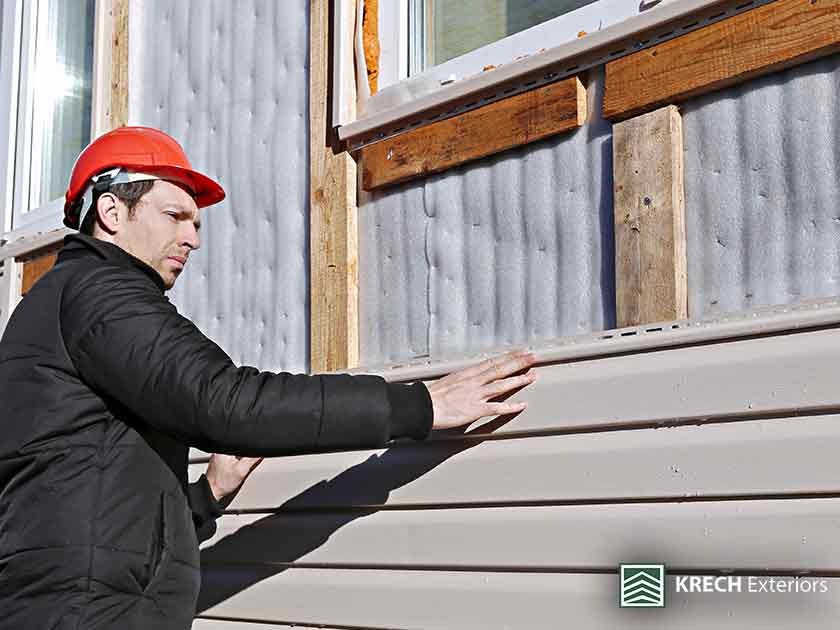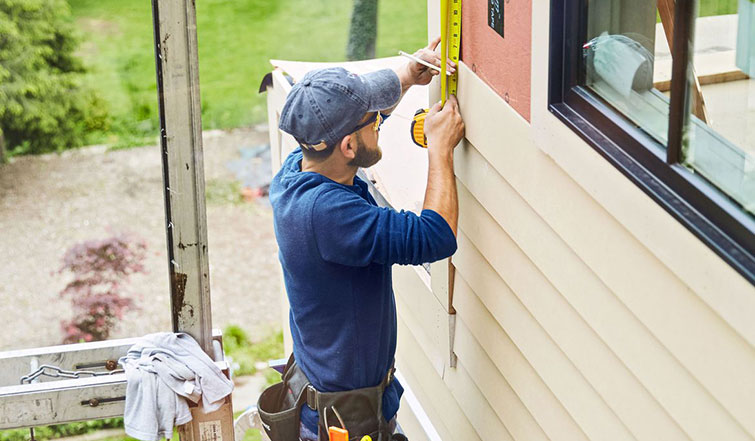Morris Siding Contractor Known for High-End Installations and Customer Care
Morris Siding Contractor Known for High-End Installations and Customer Care
Blog Article
The Important Guide to the Different Types of Exterior Siding and Their Special Advantages
In the realm of home enhancement, selecting the ideal home siding is a crucial decision that affects both aesthetic allure and practical performance. With so numerous choices to take into consideration, which home siding material absolutely stands out for your certain job?
Timber Exterior Siding
Timber home siding, a preferred option for domestic outsides, provides a timeless visual that combines all-natural beauty with architectural integrity. This home siding material is available in different designs, including clapboard, shingles, and board-and-batten, allowing home owners to tailor their façade to match their layout choices. Wood house siding is normally crafted from durable varieties such as cedar, redwood, or want, which are understood for their strength and capacity to stand up to ecological stressors.
One of the primary benefits of timber house siding is its exceptional insulation homes, which can add to power effectiveness and reduced home heating expenses. Furthermore, timber house siding is eco-friendly, making it an environmentally pleasant option when sourced sustainably. Regular upkeep, consisting of paint or discoloration, can lengthen its life expectancy and improve its appearance, enabling home owners to maintain the natural beauty of the wood.
However, prospective downsides include sensitivity to insects, rot, and climate damage, demanding appropriate treatment and maintenance - morris siding contractor. In spite of these problems, when appropriately cared for, wood house siding can give a sturdy and stunning solution that enhances the personality of a home while using a cozy, inviting atmosphere

Plastic House Siding
Plastic siding has become a leading option for home owners seeking a low-maintenance exterior option that integrates durability and price. This versatile product is crafted from polyvinyl chloride (PVC), making it immune to various weather, including moisture and UV rays. As a result, plastic siding does not warp, rot, or discolor, guaranteeing long-lasting aesthetic allure.
One of the main benefits of vinyl house siding is its substantial variety of styles and colors, permitting property owners to achieve the desired try to find their property without the demand for constant repainting. In addition, vinyl siding is easy to mount, which can considerably lower labor expenses throughout building and construction or restoration jobs.
Plastic home siding likewise contributes to power performance. Many choices feature insulation support, which boosts thermal performance, assisting to keep comfortable interior temperatures and possibly lowering power bills. Its smooth surface facilitates easy cleaning, requiring only routine washing with a yard hose to get rid of dirt and particles.
Fiber Cement House Siding
Fiber concrete siding has gained grip among builders and homeowners alike due to its amazing mix of longevity and aesthetic flexibility. Made up of a mix of sand, cellulose, and concrete fibers, this house siding choice is crafted to endure extreme weather, including high winds, hefty view it rain, and temperature changes, making it a durable option for property outsides.

Among the primary benefits of fiber concrete home siding is its resistance to insects, such as termites, and its non-combustible nature, offering improved fire safety and security. morris siding contractor. In addition, it is offered in a wide variety of textures, shades, and designs, allowing home owners to achieve their preferred visual without sacrificing efficiency
An additional advantage is its low upkeep needs; fiber cement home siding normally calls for painting or staining every 5-10 years, which is less constant than various other materials. Furthermore, its longevity contributes to a lower overall expense of possession, as it decreases the need for constant repair services or replacements.
Inevitably, fiber cement home siding stands for an outstanding investment for those looking for a durable, eye-catching, and functional outside option, combining both form and function to enhance the home's visual allure.
Metal Siding
The attraction of metal exterior siding exists in its robust resilience and contemporary visual charm, making it a preferred selection for modern architecture. Offered in products such as aluminum and steel, metal exterior siding supplies an array of shades and surfaces, permitting home owners to attain an individualized appearance that matches their style vision.

Power efficiency is another significant advantage, as many metal home siding items are created with insulation choices that help regulate indoor temperature levels. This can cause decreased energy expenses in time. Additionally, review metal home siding is typically recyclable, making it an eco pleasant option for sustainability-minded property owners.
The setup process for steel siding can be reasonably straightforward, resulting in a quicker turn-around time for construction projects. In general, metal siding combines functionality and style, making it a functional alternative for those looking for a long-lasting and visually attractive outside coating.
Brick and Rock Home Siding
Brick and rock siding stands apart as a classic choice that improves the aesthetic appeal of any home. Known for their longevity and low maintenance, these products give a phenomenal return on financial investment while raising the residential or commercial property's visual allure. Offered in various shades, appearances, and patterns, brick and stone can be tailored to match diverse architectural designs, from traditional to contemporary.
One of the primary benefits of brick and rock siding is their energy efficiency. Both products possess all-natural insulating properties that assist regulate indoor temperature levels, potentially lowering home heating and cooling expenses. Furthermore, they supply premium fire resistance contrasted to other exterior siding choices, adding to enhanced security.
Another advantage is their durability. Block and stone can last for decades, commonly requiring minimal upkeep beyond occasional cleaning. Unlike wood exterior siding, they are impervious to parasites and rot, guaranteeing a long-lasting outside that stands up to the elements.
Conclusion
In recap, the choice of house siding considerably affects a home's visual allure, power efficiency, and upkeep needs. Each type of house siding-- whether wood, vinyl, fiber cement, her response steel, or block and rock-- offers one-of-a-kind benefits customized to numerous property owner choices and ecological conditions.
One of the key advantages of wood house siding is its excellent insulation properties, which can add to power efficiency and lower heating expenses. Furthermore, timber home siding is eco-friendly, making it an environmentally friendly choice when sourced sustainably.One of the primary benefits of metal exterior siding is its resistance to numerous environmental aspects.Energy efficiency is another considerable advantage, as lots of steel siding items are made with insulation options that assist control interior temperature levels. Each kind of siding-- whether wood, plastic, fiber metal, cement, or brick and stone-- supplies distinct advantages customized to various property owner preferences and environmental problems.
Report this page